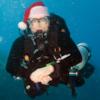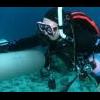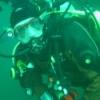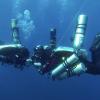
Your Octo - alternatives for your alternate
#16

Posted 01 August 2008 - 06:06 PM
When i do photos i tend to add a % to my requirements, but it is along the line of how i plan for a more advanced dive to plan for contingencies. In any case I know what my tidal volumes and such so its to the point i know how much i will pull out of a tank a minute to the point where i have noted the number in my head and when i did my next check (a minute later) I was right where i thought it was gonna be. Now that i havent dove that much this year my SAC rate has really sucked so im gonna have to add a little bit more to that planning
Secretsea18 i will agree with you on that staying down till its gone, and i wish they would give a refund
A Novus Dies Has Adveho.... Occupo Dies
Where in the World is Tooth? ... Catch Me It You Can!
Traveling the World, Diving, and Photography, on my days off from saving lives as a Paramedic
#17

Posted 01 August 2008 - 06:12 PM
my SAC rate has really sucked
From the thread...I'm assuming SAC refers to your breathing rate...but what does it stand for?
#18

Posted 01 August 2008 - 06:15 PM
from your SAC rate, you can figure out how much gas you need to do any dives
#19

Posted 01 August 2008 - 06:17 PM
it means Surface Air Consumption
from your SAC rate, you can figure out how much gas you need to do any dives
In what kind of specialty course or general diving class would I learn about this?
#20

Posted 01 August 2008 - 06:21 PM
I don't dive with people who run out of air.

How do you run out of air anyway?????
Well sometimes people blow O-rings, sometimes the same person twice in one week! We may not donate our second and save your ass but us photographers will document what happened
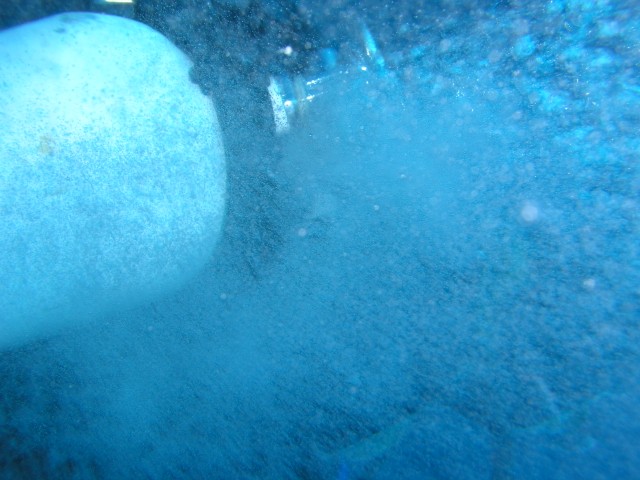
By all that is wet, I do hereby swear, (politely), and attest, upon pain of never diving again, (real or imagined), that I understand and affirm, that I agree to the above.
_________________________________________(log in name signature)
Signed and Dated
#21

Posted 01 August 2008 - 06:27 PM
A Novus Dies Has Adveho.... Occupo Dies
Where in the World is Tooth? ... Catch Me It You Can!
Traveling the World, Diving, and Photography, on my days off from saving lives as a Paramedic
#22

Posted 01 August 2008 - 06:35 PM
I learned to calculate and use the SAC rate in an Adv Nitrox/Deco Procedures classit means Surface Air Consumption
from your SAC rate, you can figure out how much gas you need to do any dives
In what kind of specialty course or general diving class would I learn about this?
but it is a good thing to know about yourself for general diving too - for example, I don't like diving deeper than 90' on an AL80 because an HP100 matches my SAC rate better at that depth
#23

Posted 01 August 2008 - 07:20 PM
To measure our air consumption we need to do it in relation to the surface or we really can't compare dives. If you did two identical dives one at 33 feet and one at 66 feet then you will use more air for the 66 foot dive, assuming equal workload etc. By converting your air consumption to an equivalent value as if you were standing on the surface, you can compare different dives and see if you are generally improving or not.
So let's take a 20 minute dive to 66 feet where you used 2000 psi and were diving with an AL80 rated at 3000psi working pressure - (btw, an AL80 is actually 77 cubic feet)
77 cubic feet x 2000 psi / 3000 psi = 51.3 cubic feet of air used.
51.3 cubic feet / 20 minutes = 2.56 cubic feet / minute at 66 feet depth.
At 66 feet the air is 3 times denser than at the surface and so divide by 3 to get a 0.85 cf/minute Surface Air Consumption (SAC) Rate.
Now, when you dive again, you could use this SAC rate as a predictor of your bottom time, so in the same scenario, if you planned to do a square profile to 99 feet, and wanted to start up with 1500 psi, you could estimate as follows:
Depth = 99 feet, so multiply your SAC by 4 to compensate for the 4 atmospheres of pressure:
4 x .85 = 3.4 cf/minute
How much air do you have in your tank?
3000psi (working pressure) - 1500psi (ending pressure) = 1500psi available
1500/3000 x 77 cf = 38.5 cf
38.5 cu ft/ 3.4 cf/min = 11.3 minutes
Edited by Capn Jack, 01 August 2008 - 07:22 PM.
Jacques Yves Cousteau
#24

Posted 01 August 2008 - 07:42 PM
I teach the concept in my OW course. I have my students actually measure and calculate their SAC in the AOW course. This is stuff that every diver should know and be able to monitor and determine about themselves - I personally see no reason to wait until a deco course to cover this material.In what kind of specialty course or general diving class would I learn about this?
-JimG
#25

Posted 01 August 2008 - 08:16 PM
To measure our air consumption we need to do it in relation to the surface or we really can't compare dives. If you did two identical dives one at 33 feet and one at 66 feet then you will use more air for the 66 foot dive, assuming equal workload etc. By converting your air consumption to an equivalent value as if you were standing on the surface, you can compare different dives and see if you are generally improving or not.
So let's take a 20 minute dive to 66 feet where you used 2000 psi and were diving with an AL80 rated at 3000psi working pressure - (btw, an AL80 is actually 77 cubic feet)
77 cubic feet x 2000 psi / 3000 psi = 51.3 cubic feet of air used.
51.3 cubic feet / 20 minutes = 2.56 cubic feet / minute at 66 feet depth.
At 66 feet the air is 3 times denser than at the surface and so divide by 3 to get a 0.85 cf/minute Surface Air Consumption (SAC) Rate.
Now, when you dive again, you could use this SAC rate as a predictor of your bottom time, so in the same scenario, if you planned to do a square profile to 99 feet, and wanted to start up with 1500 psi, you could estimate as follows:
Depth = 99 feet, so multiply your SAC by 4 to compensate for the 4 atmospheres of pressure:
4 x .85 = 3.4 cf/minute
How much air do you have in your tank?
3000psi (working pressure) - 1500psi (ending pressure) = 1500psi available
1500/3000 x 77 cf = 38.5 cf
38.5 cu ft/ 3.4 cf/min = 11.3 minutes
Wow! Thanks!! I actually understood all of that. Now I want to go to my dive log and look at some things.
So...AL80's are really 77 cu feet, are there such variances with Steel 80's or AL100's (or other tanks...those are the ones I can think of right now)?
I teach the concept in my OW course. I have my students actually measure and calculate their SAC in the AOW course. This is stuff that every diver should know and be able to monitor and determine about themselves - I personally see no reason to wait until a deco course to cover this material.
-JimG
I think the information should at least be in the AOW information...not necessarily testing students on this...but make the info available so someone like me who every so often rereads the materials might pick it up.
Edited by uwfan, 02 August 2008 - 07:30 AM.
#26

Posted 01 August 2008 - 08:22 PM
SAC is how many psi per minute (I have seen it expressed as 'cubic feet' or 'pounds' as well in some references) you consume from your tank when just below the surface. You multiply this figure by the depth in ATA (Which I showed you how to calculate earlier) to let you plan your consumption at a planned depth. Technical divers will use their SAC rates for gas planning. This lets them plan on taking only the amount of gas they need for their dive plan instead of dragging tanks along they may not need.In what kind of speciality course or general diving class would I learn about this?
For example, if you are diving at 1 foot and use 250 psi in 10 minutes, then your SAC rate is 25 psi per minute (consumption in psi divided by the time in minutes) So an AL80 @3000 psi will last 120 min.
@ 33 feet the pressure is twice that at the surface, and so you take your SAC and multiply it by the ATA or 2.0. Now you use 50 psi in 1 minute. AL80 lasts 60 min.
@ 66 feet the pressure is three times that at the surface, and so you take your SAC and multiply it by the ATA or 3.0. Now you use 75 psi in 1 minute. AL80 lasts 40 min.
@ 99 feet four times = 100 psi in 1 min. AL80 lasts 30 min.
@ 132 feet five times = 125 psi in 1 min. AL80 lasts 24 min. etc...
Capn Jack's math shows you how this works in much more detail in cf. Note: Remember NDL limits still apply. Just because your SAC says you can stay at 132 feet for 24 minutes does not invalidate the table or your DC limits.
SAC's as stated, are used for theoretical gas planning. As time goes by and you become more relaxed in the water your SAC rate should decrease therefore increasing time. When you have as many dives as WreckWench it even goes negative.
There is a Dive Physics attachment below with lots of detailed info on that and other things you may find interesting. Enjoy.
Attached Files
Tech Support - The hard we do right away; the impossible takes us a little longer...
"I like ponies on no-stop diving. They convert "ARGH!! I'M GOING TO DIE" into a mere annoyance." ~Nigel Hewitt
#27

Posted 01 August 2008 - 10:17 PM
I check my guage every 5 minutes during the dive, but only to back up my own calculations. If I look at my guage and I have more gas than my estimate I'll look for a problem (left post rolled off).
As for my config...primary reg on the 7' hose, backup bungeed around the neck--for all my diving. As fpr DG's questions, my secondary is a full sized reg. I'll be upgrading it to a SCUBA Pro S600 in the future.
#28

Posted 01 August 2008 - 11:53 PM
I actually use 2 balanced regs, but do use an unbalanced on my stage, or deco gas if it's going to stay with me.
I thought of something else.
Seems I remember reading somewhere that your secondary reg (necklaced) should be unbalanced if your primary is balanced or vice versa. The thinking being an environmental situation that would cause one to fail wouldn't effect the other in the same way.
Opinions? Facts (please - although opinions are so much more fun)
#29

Posted 02 August 2008 - 07:30 AM
Edited by NJBerserker, 02 August 2008 - 07:33 AM.
#30

Posted 02 August 2008 - 07:45 AM
My computer is not air integrated nor will I ever have one. Granted their kind of cool, but must be backed up with an analog SPG which would be just another hose to deal with so I don't see the point. If the you-know-what hit's the fan the crucial information you need is your depth, bottom time, and gas remaining. If my computer fails I have all of those available with my watch and analog gauges.
Just for clarification, do you only have an SPG attached to your tank or do you also have a depth gauge attached? If you don't have both, which piece gives you your depth if your computer fails?
0 user(s) are reading this topic
0 members, 0 guests, 0 anonymous users

